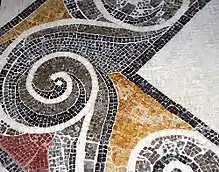 Roman remains at San Pawl Milqi | |
| Location | Burmarrad, St. Paul's Bay, Malta |
|---|---|
| Type | Roman villa |
| Website | www.heritagemalta.org |
San Pawl Milqi ("Saint Paul the welcome or the healer" in maltese[1]) are the ruins of a Roman period agricultural villa and pagan temple, the largest ever discovered in Malta. A Christian church was built on the site based on the Biblical mention of the shipwreck of Saint Paul on the island. In the place of the current chapel there was a temple dedicated to the Greek god Apollo and a Roman villa. According to religious tradition, the villa is where Saint Publius, Governor and first Bishop of Malta, received Saint Paul after his shipwreck.[2] [3]
Apart from the account of the Acts of the Apostles there are no other authors who narrate the episode and no later writer complements the tradition. [4] There has even been a controversy about whether the event occurred in Malta, since the Greek text says Melite (traditionally understood as Malta).
There is no archaeological evidence in support of Christian claims, and it is considered a name dating to the Middle Ages. Evidence of Christian worship on the site only dates back to the building of the first chapel in the fourteenth century.[5][6] According to Anthony Bonanno, archeological research in the entire area of St Paul’s Bay found no evidence of the Christian tradition related to the supposed shipwreck in the area.[7]
History

The site has been in use since prehistoric times; a couple of tombs date back to the Zebbug and possibly the Borg in-Nadur phases of the Maltese Bronze Age.
The first building on the site was probably built in the Phoenician-Punic period, when the site was used intermittently for agriculture. A small number of structures remain from this period and one burial bears a neo-Punic inscription.
In the Roman period, the site’s position on the slopes of a fertile valley and vicinity to the Roman harbour at Salina meant that it was ideally suited to the production of olive oil. The establishment was expanded; the original central courtyard was transformed into an industrial area. The trapetum (a rotating mill used to separate pips from olive fruit), anchor points and at least two presses can still be seen, as well as a set of settling vats used to purify oil.
Although large enough to have been the property of a rich aristocrat, the villa does not contain any residential quarters of any particular richness. The four rooms which can be identified as serving residential needs were, in fact, only decorated with painted wall plasters and common cocciopesto flooring.
The site was eventually reduced in size and surrounded by a thick fortification wall. This wall was erected circa the third century A.D. by the Romans as a mean for defence from invaders.[9] Its fortified walls, constant water supply and good position meant that it was ideally located to control the nearby port and valleys.
During the Arab period the site was majorly destroyed due to sea invasions and attacks. The Arabs decided to use the remains to fortify the site with limited construction techniques.[10][11]
A church was built on part of the site in the fourteenth century, but after more than a century it fell into disuse and in 1616 was replaced by a church dedicated to the welcoming of St. Paul. This church, which still stands today, is the oldest record connecting the site to the traditional event.
Excavation
Although the remains of the villa have long been well known, scientific excavations, led by the Missione Archeologica Italiana a Malta, did not commence until 1963. The final report on these excavations is yet to be published.
The site was included on the Antiquities List of 1925.[12]
Today
Today, the site is managed by Heritage Malta and closed to the public except for annual occasions.
References
- ↑ https://timesofmalta.com/articles/view/san-pawl-milqi-decoded.225623
- ↑ Caruana, A. A. (1883). Report on the PHOENICIAN and Roman antiquities in the group of the islands of Malta (Report). pp. 144–147.
- ↑ Ellis, Edward Earle; Son, Sang-Won (2006). History and Exegesis: New Testament Essays in Honor of Dr. E. Earle Ellis on His Eightieth Birthday. A&C Black. p. 86. ISBN 9780567028013.
- ↑ Caruana. D., V. (1916). "San Publio nella storia (con.)" (PDF). La Diocesi. 1 (7): 140.
- ↑ Buhagiar, Mario (1993). "The St. Paul Shipwreck Controversy an Assessment of the Source Material" (PDF). Proceedings of History Week. Malta: The Malta Historical Society: 181–213.
- ↑ Buhagiar, Mario (1993). "The St. Paul Shipwreck Controversy an Assessment of the Source Material" (PDF). Proceedings of History Week. Melitensia: 181–213.
- ↑ Bonanno, Anthony (1995). "Underwater Archeology: A New Turning-Point in Maltese Archeology" (PDF). Hyphen. 7 (3): 107.
- ↑ Sagona, Claudia (2015). "Malta's Place in the Roman World". The Archaeology of Malta: From the Neolithic through the Roman Period (Cambridge World Archaeology. Cambridge University Press. pp. 264–295. doi:10.1017/CBO9781139030465.009. ISBN 9781139030465.
- ↑ Ltd, Allied Newspapers. "Roman villa that welcomed Paul". Times of Malta. Retrieved 12 March 2018.
- ↑ Mahoney, Leonard (1996). 5000 Years of Architecture in Malta. Valletta Pub. p. 33. ISBN 9789990958157.
- ↑ De Lucca, Denis (1985). "Islamic Architectural Manifestations in 18th century Mdina" (PDF). Hyphen: Journal of Melitensia and the Humanities. Malta. IV (5): 168.
- ↑ "Protection of Antiquities Regulations 21st November, 1932 Government Notice 402 of 1932, as Amended by Government Notices 127 of 1935 and 338 of 1939". Malta Environment and Planning Authority. Archived from the original on 19 April 2016.
